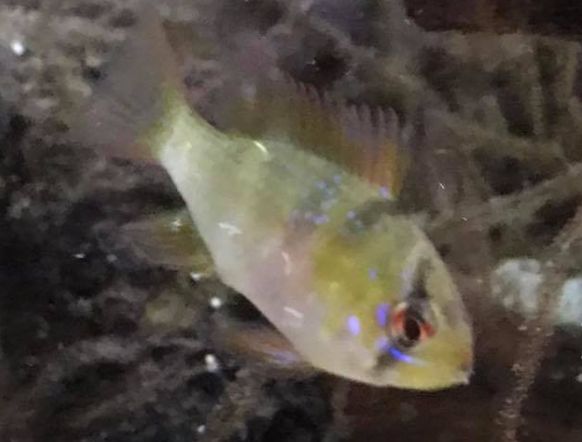
Anchor worms are a parasite of tropical fish which have visible parts which look like white cotton threads 1/8 to 1 inch long hanging off the body or fins of a fish. The short white threads move with the current, which distinguishes them from any other disease such as ich.
It was once thought there are many species which are of different lengths and appearances. Some are very long, thin and light brown, white or gray. Some are even dark brown. Some are rigid. It turns out all these are only different forms of one species, Lernaea cyprinacea. (“Biology of Anchor Worms (Lernaea cyprinacea)”, Hossain, et. al. 2018). Anchor worms are common in goldfish but can be found on any fish or even on amphibians like frogs.
Anchor worms burrow into the fish, sometimes into the organs. The “worms” feed on the internal fluids of the fish. They then protrude from the fish’s body to release their eggs. Sometimes the “worms” have two short arms at the end of the “worm” that is in the water. These arms are actually egg sacs. But note these egg sacks are often absent and there are thus NOT two “legs” present.
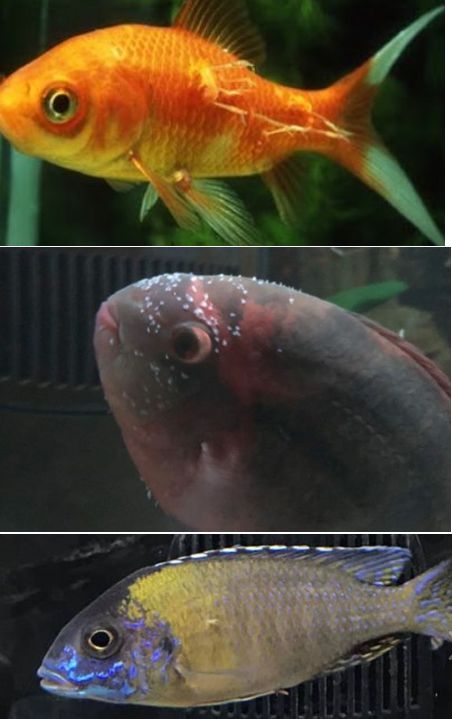
Anchor worms are technically not a worm at all but a Lernaea species, a type of copepod crustacean of the arthropod family. A mated female embeds her head into the scales of the host fish. She then burrows deep into the flesh of the fish. The females then begin releasing eggs into the water column of the aquarium. Each of these eggs hatches and begin free-swimming as a bug-like larva in the aquarium. There are typically several complex life stages of the larvae in the water over a span of 15 to 30 days.
When a larvae at the proper infective stage finds a fish, they crawl around in the mucus coat until they find a mate. After mating the females transform into worm-like creatures and begin a new cycle. A single female anchor worm can produce hundreds of larvae every two weeks for up to 16 weeks in a 77F (25C) tank. In the confines of an aquarium this spreads much like ich spreads.
Sometimes the worms concentrate in one area of the body of a fish and create a small colony. This colony then typically gets infected with bacteria and a big mucus covered ulcer will form.
The “worms” that can be seen have the ability to disappear under the scales of the fish if presented with an irritant in the water. This often results in people saying the infection comes and goes with time, being “cured” one day only to reappear the next day.
Sometimes fish are killed by a long burrowing anchor worm. When the fish dies the oxygen levels in the fish drop and the worm will crawl out of the body of the fish. This decidedly upsets some fish keepers.
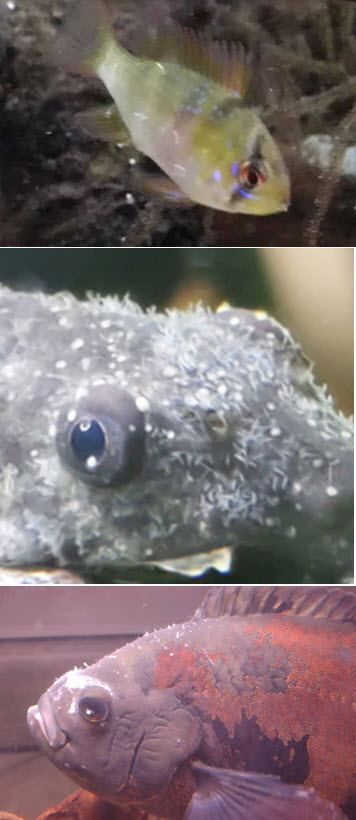
Treatment
Carbamate insecticides such as aldicarb (Temik), carbofuran (Furadan), and carbaryl (Sevin) will kill even adult anchor worms if treatment is continued at 0.5 ppm (0.18 grams per 100 gallons, not a lot) twice a week in the water for two months. Nicotinoid insecticides such as Imidacloprid have a similar utility.
The oral dog medications ivermecten and doramectin will kill even adult anchor worms in fish. Add these medications to some food (see directions below) and feed for four weeks minimum. Note that with COVID, these medications have become very hard to get.
Anchor worms are arthropods and have an exoskeleton. In arthropods, exoskeleton development is interfered with by organophosphate insecticides. So anchor worm nymph stages in the water can be treated with insecticides like trichlorofon (Blue Planet ParaCide), cyromazine (Microbe-Lift Lice and Anchor Worm Treatment), Dylox (Dyacide) and diflubenzuron (Dimilin-X, Jungle Labs Anchors Away, JBL Aradol). This will NOT kill adults on the fish.
Other organophosphate insecticides such as malathion, chlorpyrifos and diazinon can be used at one drop per 25 gallons. Note Fritz Aquatics Mardel Clout (Metronidazole and Trichlorfon) is no longer being sold. The availability of these medications varies greatly depending on the nation where one is located. Put the insecticide into the water column. It won’t affect the beneficial bacteria in the filter. The treatment should be once a week for two months.
Do NOT use household insecticides to treat anchor worms. Most household insecticides are a class of insecticides known as pyrethrinoids and these are VERY toxic to fish.
Anchor worms can also be killed by copper medications at the same strength as recommended for treating ich. Coppersafe and Seachem Cupramine are two such copper medications. Do not use copper medications in water with a GH lower than 6. If one has soft water, raise the GH by adding ground up Tums tablets or putting crushed coral into the filter in a bag. It is then safe to use a copper medication.
The long lived adult anchor worms on the fish themselves are very resistant to medications. But the larvae in the water can be killed by medications much easier, stopping the life cycle. This is why treatment must be continued for two months. And one should expect to see the “worms” on the fish intermittently for up to two months.
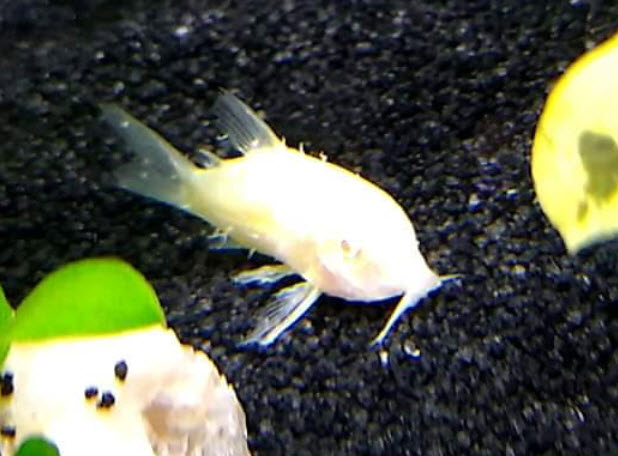
Secondary Infections
If the worms have created ulcers or red spots it is best to treat with a broad spectrum antibiotic in the food as secondary bacterial infections can kill fish quite rapidly.
Bacterial diseases need to be hit with a broad-spectrum antibiotic. These need to be obtained from the internet. They include Thomas Labs Fish Mox, Midland Vet Service Aqua-Mox, VetDepot Amoxicillin, SeaChem KanaPlex, Fishbiotic Ampicillin, Mardel Maracyn 2, Thomas Labs Fish Min and Thomas Labs Fish Doxy. They are ONLY effective when mixed with the food (contrary to manufacturers profit driven instructions).
It is easy to make medicated food. Heat 1/4 cup water (two ounces or 58 milliliters, not a lot) in the microwave. Then blend seven grams of plain animal derived gelatin (Knox gelatin, one packet) into the hot solution with vigorous stirring. Take two tablespoons of dry commercial fish food (pellets or flake) and mix it with just a little of the hot water/ gelatin mixture. Let the food sit for a few minutes to absorb the water. Add hot water/gelatin until you get a paste like consistency. If it gets too watery just add more food.
Then add roughly 1/16 teaspoon (a 1% to 2% addition) of the medication to the mud. Mix and mash the whole mass thoroughly. Spread it out into a pancake about 1/8th inch (3 mm) thick on a plastic film or a plate. Then put in the refrigerator. If you plan on keeping it for more than two weeks put it in a small plastic bag and freeze.
Treatment needs to be for at least two weeks. If it is one or two fish transfer the fish to a hospital aquarium and treat. If more than two fish have the problem one must treat the whole aquarium.
External “Worms” on Shrimp
There is another type of external worm found in shrimp colonies. It is called Scutariella japonica. It is a small worm like creature that stick out into the water and feeds off detritus. It uses shrimp or crayfish (“lobsters”) to attach to while it feeds. It is harmless in general.
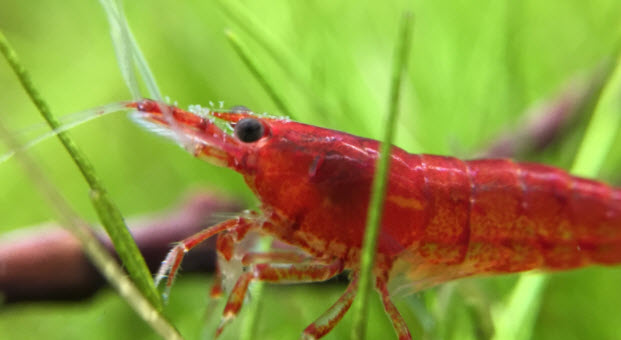
Scutariella japonica is a type of flatworm, related to tapeworms and planaria. Praziquantel is the drug of choice, but fenbendazole can be used if there are no snails in the tank.
Return to Diseases Menu
.
Aquarium Science Website
The chapters shown below or on the right side in maroon lead to close to 400 articles on all aspects of keeping a freshwater aquarium. These articles have NO links to profit making sites and are thus unbiased in their recommendations, unlike all the for-profit sites you will find with Google. Bookmark and browse!
.

Dave says
In reply to CAT ….. Simply buy anyone of the following and follow the directions that come with the product: trichlorofon (Blue Planet ParaCide), cyromazine (Microbe-Lift Lice and Anchor Worm Treatment), Dylox (Dyacide) and diflubenzuron (Dimilin-X, Jungle Labs Anchors Away, JBL Aradol)
Catherine says
Hi!
I have an amazon puffer with a a severe anchor worn infestation. Currently treating him in a 10 gallon QT with copper guard and salt. I have a feeling this won’t be enough. What do you recommend trying? And recommendations for dosing ivermectin orally or adding insecticides to the water?
Thanks,
Cat
Cat says
Hi!
I have an amazon puffer with a a severe anchor worn infestation. Currently treating him in a 10 gallon QT with copper safe and salt. I have a feeling this won’t be enough. What do you recommend trying? And recommendations for dosing ivermectin orally or adding insecticides to the water?
Thanks,
Cat
Dave says
In reply to Ashley …… Just treat with the Para-Gone and your fish should be just fine. I wouldn’t use permanganate. It can kill.
Ashley Bennallack says
Hi,
I’ve just ordered the product below to try to treat 1 super stubborn anchor worm that is embeded in the wen of my short tail oranda.
I’ve treated with API General Cure, Prazi Pro and antibiotics previously (because I had no idea what I was trying to fix) bit I’m pretty sure its anchor worm now because it has a thin black sticking out from what has previously just looked like a black spot in the wen.
The Product:
Aquasonic Para-Gone Parasite Treatment (Trichlorphon)
My question is – should I also use a permanganate dip once a week or should I just be patient with the above?
Or will this product not work and I should try a copper medication?
I am not confident enough to remove the worm myself so I need medication to do the trick for me! The fish is a beautiful, $500 A Grade Oranda that I really want to save!!!